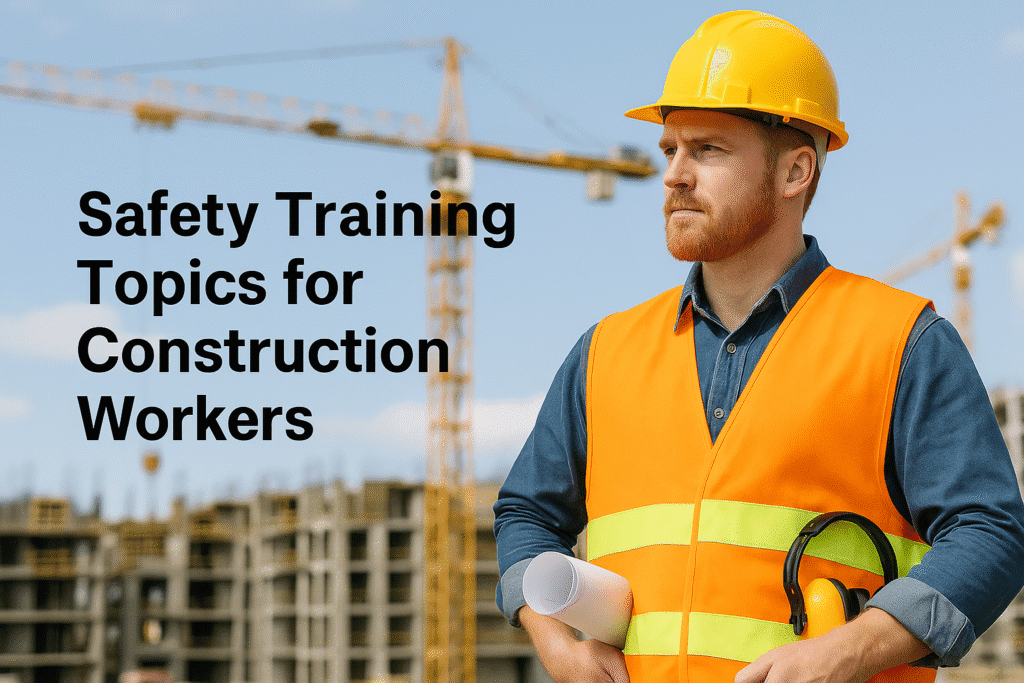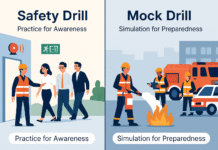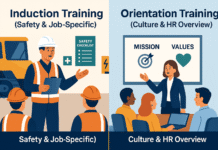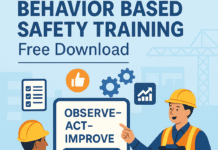
Safety Training Topics for Construction Workers
Construction is often called one of the most dangerous professions in the world. From working at towering heights to handling heavy machinery, construction workers face a wide range of hazards every single day. According to the International Labour Organization (ILO), thousands of construction-related fatalities occur each year worldwide, and millions of workers suffer injuries, many of which could have been prevented with the right safety measures.
This is why safety training is not just a box to tick for compliance—it’s a life-saving necessity. In this article, we will dive deep into the essential safety training topics for construction workers, explore practical examples, and highlight how these programs can foster a culture of safety on-site. Whether you’re a safety officer, project manager, or worker, these training areas can drastically reduce accidents and make construction projects more efficient.
Understanding Safety in Construction
Construction sites are complex environments where multiple tasks, contractors, and hazards overlap. Workers may encounter risks such as:
- Falls from height.
- Electrical shocks.
- Struck-by accidents from vehicles or equipment.
- Chemical exposure.
- Fires and explosions.
- Confined space hazards.
- Trench collapses.
Safety training is essential because it provides workers with the knowledge to recognize these hazards and the skills to protect themselves. Regulations such as OSHA standards in the U.S. and similar frameworks in other countries mandate training to keep workers safe and employers accountable.
Real-World Example:
On a high-rise construction project in Dubai, scaffolding collapsed because it was overloaded. Several workers suffered severe injuries. An investigation revealed they had not received proper training in scaffold load limits and inspection. This shows how a lack of training can turn small mistakes into catastrophic events.
Personal Protective Equipment (PPE)
Why PPE Matters
Personal Protective Equipment acts as the last line of defense. Even with engineering and administrative controls, hazards still exist, and PPE helps minimize their impact.
Types of PPE in Construction
- Head Protection: Hard hats to prevent head injuries from falling objects.
- Eye and Face Protection: Safety goggles or face shields to protect against sparks, dust, and chemicals.
- Hearing Protection: Earplugs or earmuffs to prevent long-term hearing loss from noisy machinery.
- Hand Protection: Gloves for different tasks—cut-resistant, chemical-resistant, or insulated.
- Foot Protection: Steel-toed boots to guard against crushing injuries.
- Body Protection: High-visibility vests and protective clothing.
- Respiratory Protection: Dust masks or respirators for environments with harmful fumes.
Training Content
Workers should be trained not only on when to use PPE but also on proper fit, inspection, and maintenance. A damaged hard hat or torn glove is worse than having none, as it gives a false sense of safety.
Fall Protection Training
The Risk of Falls
Falls account for over 35% of fatalities in construction. Workers often underestimate risks when working just a few meters above ground, but even short falls can cause life-changing injuries.
Training Includes:
- Proper use of harnesses, lanyards, and lifelines.
- Identifying anchor points and their strength requirements.
- Installing guardrails and toe boards.
- Using safety nets in large construction zones.
- Rescue planning—what happens if someone does fall.
Case Study:
A roofing company in Texas faced fines after two workers died due to lack of fall protection. Neither wore harnesses, and there was no guardrail system. The tragedy could have been avoided with proper training.
Scaffolding Safety
Hazards in Scaffolding
Improper scaffolding accounts for a large number of accidents. Common hazards include falls, collapsing structures, and falling objects.
Safe Practices Training
- Ensuring scaffolds are erected and dismantled by trained personnel.
- Checking that scaffolds are level, stable, and not overloaded.
- Installing guardrails and midrails.
- Regular inspection before every shift.
Checklist for Workers:
- Did I check the scaffold tags?
- Are planks secured properly?
- Is the base on stable ground?
Ladder Safety
Risks
Falls from ladders may seem minor, but they are a leading cause of injuries.
Training Covers:
- Choosing the correct ladder (step, extension, or platform).
- Placing it at the correct angle (4:1 ratio).
- Maintaining three-point contact at all times.
- Avoiding carrying heavy tools while climbing.
Electrical Safety
Common Electrical Hazards
- Contact with overhead power lines.
- Damaged power cords.
- Improper grounding of equipment.
- Wet environments leading to electrocution.
Training Includes:
- Lockout/Tagout (LOTO) procedures.
- Safe use of portable tools.
- Recognizing damaged cords and reporting immediately.
- Using Ground Fault Circuit Interrupters (GFCIs).
Fire Safety and Emergency Response
Fire Hazards on Sites
Construction sites often store flammable liquids, compressed gases, and conduct hot work like welding or cutting.
Training Focus Areas:
- Fire prevention through proper storage.
- Types of fire extinguishers and their use.
- Emergency evacuation drills.
- Communication systems for fire response.
Example:
During the construction of a shopping mall, a welding spark ignited insulation material, leading to a major fire. Workers trained in extinguisher use prevented further escalation until firefighters arrived.
Confined Space Safety
Why It’s Dangerous
Confined spaces like tunnels, tanks, or manholes often have poor ventilation, toxic gases, or oxygen deficiency.
Training Should Cover:
- Permit-to-work systems.
- Gas monitoring equipment use.
- Ventilation techniques.
- Emergency rescue planning.
Tip: Always have an attendant outside a confined space to monitor conditions and workers.
Hazard Communication (HAZCOM)
Why It’s Important
Workers frequently handle paints, solvents, adhesives, and cleaning agents. Without proper training, chemical burns, poisoning, or respiratory issues can occur.
Training Includes:
- Understanding Safety Data Sheets (SDS).
- Reading and interpreting chemical labels.
- Safe storage and disposal of chemicals.
- Using PPE specific to chemical handling.
Heavy Equipment and Machinery Safety
High-Risk Equipment
Cranes, bulldozers, forklifts, and excavators can cause fatal accidents if not handled correctly.
Training Content:
- Pre-operation inspections.
- Blind spot awareness and use of spotters.
- Load limits and signaling.
- Emergency stop procedures.
Case Example:
An excavator operator accidentally struck underground power lines because site-specific hazard training was skipped. This resulted in severe injuries and project delays.
Excavation and Trenching Safety
Hazards
Cave-ins are the most lethal hazard in excavation work.
Training Topics:
- Soil classification and risk assessment.
- Protective systems like sloping, benching, shoring, and shielding.
- Keeping heavy equipment away from trench edges.
- Never entering an unprotected trench.
Manual Handling and Ergonomics
Why It Matters
Back injuries are among the most common causes of lost workdays in construction.
Training Covers:
- Proper lifting techniques (bend knees, not back).
- Using lifting equipment like hoists or cranes.
- Team lifting for heavy or awkward loads.
- Recognizing signs of fatigue or strain.
Workplace Housekeeping
The Importance
A messy site isn’t just unpleasant—it’s dangerous.
Training Includes:
- Keeping walkways clear.
- Safe storage of tools and equipment.
- Proper waste disposal.
- Preventing slips, trips, and falls.
Health and Hygiene
Construction Health Concerns
- Heat stress and dehydration.
- Dust-related illnesses (silicosis, asbestosis).
- Fatigue from long shifts.
Training Content:
- Hydration and rest breaks.
- Using dust masks or respirators.
- Recognizing early signs of heatstroke.
- First aid basics for injuries.
Behavior-Based Safety
Changing the Mindset
Safety isn’t just about rules; it’s about habits. Behavior-Based Safety (BBS) training focuses on creating a culture where workers look out for each other.
Training Covers:
- Peer observations and feedback.
- Rewarding safe behavior.
- Reporting near misses.
Toolbox Talks and Ongoing Training
Why They Matter
Safety training isn’t effective if it’s a one-time session. Toolbox talks are short, site-specific discussions that keep safety top of mind.
Examples of Toolbox Talk Topics:
- Hot weather safety.
- Safe tool usage.
- Working at night.
- Fall protection refreshers.
Conclusion
Construction is inherently risky, but risks can be controlled with the right safety training. From PPE to confined space procedures, every topic plays a role in protecting workers and ensuring projects run smoothly. A safe worker is a productive worker, and a strong safety culture benefits both employees and employers.
When training is taken seriously, accidents are minimized, morale improves, and projects finish on time and within budget. Simply put, investing in safety training is investing in lives.
15 EHS Training Topics for a Safer Workplace
Monthly Safety Training Topics
Types of Safety Training for Employees
Types of Safety Training for Employees
FAQs
1. Why is safety training essential for construction workers?
Because construction involves high-risk activities, safety training helps workers identify hazards, use equipment correctly, and respond to emergencies.
2. How often should safety training be conducted?
Initial training should be given at onboarding, with regular refresher courses and daily toolbox talks.
3. What is the most important safety training topic?
Fall protection is often the most critical because falls are the leading cause of construction fatalities.
4. Who is responsible for ensuring workers are trained?
Employers are legally responsible, but supervisors and safety officers enforce and monitor training.
5. Can safety training improve productivity?
Yes. Fewer accidents mean less downtime, better morale, and faster project completion.
























